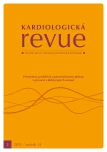-
Medical journals
- Career
Tabacco smoking and personalized approach in prevention and treatment
Authors: H. Rosolová
Authors‘ workplace: Centrum preventivní kardiologie, II. interní klinika LF a FN v Plzni, UK Praha
Published in: Kardiol Rev Int Med 2011, 13(2): 96-98
Overview
The article contains a brief history of tobacco smoking. It mentions Jean Nicot, who recommended tobacco leaves for medical compresses. Tobacco smoking is today classified as a chronic lethal illness (F17). Nicotine is a simple alkaloid with characteristics of a sympatomimetic, which acts as a psychomotor stimulant, and to which most people rapidly develop a tolerance. Nicotine is a drug and is similar to amphetamines or cocaine. Regular smokers start to smoke, in 90% of cases, between the ages of 14 and 16, meaning that the prevention of smoking must be focussed primarily on this age group. People who start smoking at this age are mainly those with psychosocial problems and who come from families with a lower level of education; for this reason, the prevention of stress and assistance with psychosocial problems in children and young people from these families is the main task for society as a whole. Adults should set a proper example to children and young people; however this is a question of knowledge and education in illness prevention, a question of morale and responsibility for one’s health and a question of the protection of public health. Recommendations have been drawn up for the treatment of tobacco dependency, which include: brief interventions by healthcare workers in the course of routine work, more intensive specialist support in specialised centres and pharmaceutical assistance. However, this approach must be continually improved, primarily through an individualized approach to every smoker to opt for it. This would be chosen based on findings on the psychosocial, health, and genetic basis of their dependency.
Keywords:
giving up smoking – tobacco dependency – individualized approach – smoking prevention
Sources
1. Kannel WB. Update on the role of cigarette smoking in coronary artery disease. Am Heart J 1981; 101: 319–328.
2. Šimon J, Holeček V, Rosolová H et al. Validizace údajů o kouření a spotřebě alkoholu v populaci. Čas Lék Čes 1987; 126 : 1305–1309.
3. Králíková E, Býma S, Cífková R et al. Doporučení pro léčbu závislosti na tabáku. Čas Lék Čes 2005; 144 : 327–333.
4. Johnson EO, Morgan-Lopez AA, Breslau N et al. Test of measurement invariance of the FTND across demographic groups: assessment, effect size, and prediction of cessation. Drug Alcohol Depend 2008; 93 : 260–270.
5. Rose JE, Behm FM, Drgon T et al. Personalized Smoking Cessation: Interactions between Nicotine Dose, Dependence and Quit-Success Genotype Score. Mol Med 2010; 16 : 247–253.
Labels
Paediatric cardiology Internal medicine Cardiac surgery Cardiology
Article was published inCardiology Review

2011 Issue 2-
All articles in this issue
- Prediction and prevention of cardiovascular risk of obesity, personalized obesity treatment
- Prediction and prevention of atherosclerosis and personalized treatment of dyslipidemia
- Prediction and prevention of diabetes mellitus type 2
- Individualized therapy of arterial hypertension
- Tabacco smoking and personalized approach in prevention and treatment
- ROCKET AF study – Is the end of warfarin coming?
- Patients with high cardiovascular risk in outpatient care in Slovakia: lessons from the NEMESYS and STAIRS studies
- Thrombosis of mitral annulus as an early complication following mechanical replacement of mitral and aortal valves: case report
- A case of atypical heart failure
- Cardiology Review
- Journal archive
- Current issue
- Online only
- About the journal
Most read in this issue- Prediction and prevention of atherosclerosis and personalized treatment of dyslipidemia
- Individualized therapy of arterial hypertension
- Prediction and prevention of diabetes mellitus type 2
- A case of atypical heart failure
Login#ADS_BOTTOM_SCRIPTS#Forgotten passwordEnter the email address that you registered with. We will send you instructions on how to set a new password.
- Career

